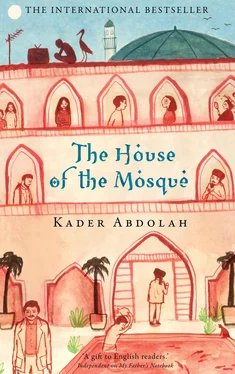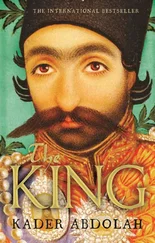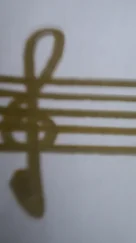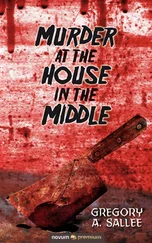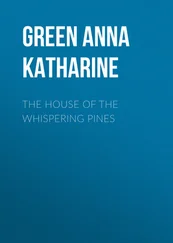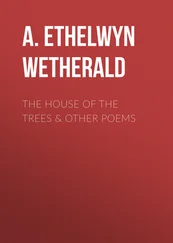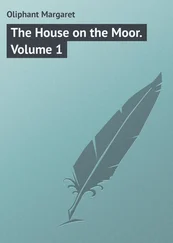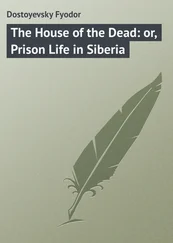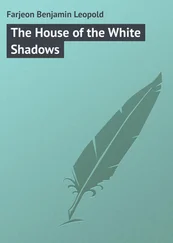The house drew its inspiration for the patterns and colours of their carpets from the feathers of migrating birds. Years of experience had taught the residents of the house that there were always a few birds in the flocks with unusual markings or striking colours on their feathers.
No one knew how Aqa Jaan dreamed up such inimitable patterns for his carpets or such an exquisite blend of colours. And through the ages it had been the women of the house who had made it possible.
Today, as in previous years, the grandmothers got to work quickly. They fetched the wicker snares from the cellar and set them out in the courtyard, on the same side of the garden as the library and the Opium Room.
The migrating birds who left the desert and headed towards Senejan usually set their sights on the minarets of the Friday Mosque. There were always four storks on the mosque, two on each minaret. No one knew exactly when the old storks died and the new ones took their place, but there were always four storks. They were a defining feature of Senejan. When the migrating birds saw them from afar, they knew they were nearing the city.
Once the birds reached Senejan, they circled noisily for a while, then landed on the roof of the mosque. The old crow perched on top of the dome and watched their every move.
The caretaker had already scattered some grain on the roof and set out bowls of water for the birds. All of Senejan knew about the grain and the water, but no one knew that Fakhri Sadat set traps for them.
Fakhri Sadat sat in a chair by the hauz , holding the ropes attached to the snares. The grandmothers hid in the library and peered through the gap in the curtains.
A flock of birds landed by the snares and started to eat the scattered grain, and as they ate, they were lured into the baskets by the raisins that had been placed there to tempt them further. The moment they stepped into the baskets, Fakhri Sadat yanked the ropes, and the snares snapped shut, trapping the birds inside.
The grandmothers hurried into the courtyard and knelt by the first basket. Golebeh lifted the lid, took out a bird and handed it to Fakhri Sadat, who studied its feathers.
This time the catch consisted of seven new types of birds. They put them in seven cages and carried them into the house.
Aqa Jaan came home after dark and went directly to his study, where Fakhri Sadat was waiting for him. ‘How did it go?’ he asked. ‘Did you catch anything special?’
‘The birds are beautiful! We saw lots of them up close,’ Fakhri Sadat replied.
‘I can’t wait to see them,’ he said. ‘Where are the grandmothers?’
‘They’re bringing in the cages,’ said Fakhri Sadat.
The four of them worked until the early hours of the morning.
Golbanu took one of the birds out of its cage and put a black hood over its head, so it would sit quietly on the table and not be frightened by the bright light.
Aqa Jaan examined its wings and feathers. ‘This one has beautiful markings, though they’re not all that unusual,’ he said, and he lifted one of the feathers with the tip of his pencil so Fakhri Sadat could see it too. Then he turned to the grandmothers. ‘Would you like to take a look?’
They put on their glasses, came closer and inspected the feathers. ‘The colours are a bit different, but we’ve seen markings like this before,’ said Golbanu. They took the bird out of Aqa Jaan’s hands and put it back in its cage, then they took out another bird and handed it to him.
‘Oh, these feathers are magnificent! See the pattern on the tip of this one? It’s a crisscross of red and green lines. I’m sure our designers can do something with this.’
Fakhri Sadat studied the feathers under a magnifying glass. ‘They’re definitely special. The shine on them makes them even more beautiful. Why do the birds in this species have such totally different feathers? Each one has a unique pattern.’
Aqa Jaan looked through Fakhri Sadat’s magnifying glass and nodded. ‘Put this one aside.’
They examined two more birds, but the feathers were quite ordinary. When the grandmothers took out the next bird, they knew right away that it was a special case. The bird refused to sit still and struggled to get free. ‘This one’s strong!’ said Golebeh. ‘Look, its feathers are also thicker than usual.’
‘This bird is indeed different,’ Golbanu agreed. ‘It has little blue dots that glitter like jewels.’
‘I looked at it briefly in the daylight,’ Fakhri Sadat said, ‘but now that I see it here on the table under a strong lamp, it looks even more beautiful.’
‘A masterpiece!’ Aqa Jaan exclaimed. ‘Where does so much beauty come from?’
Fakhri Sadat picked up a pencil and began to draw one of the feather patterns, peering at it from time to time through the magnifying glass. When she finished the sketch, the grandmothers got out an old palette and some paintbrushes.
The women didn’t realise that they were artists. In their eyes they were simply carrying on a family tradition, one that involved the carpet trade. They wanted to create the most beautiful carpets in the country, the most beautiful in all of the Middle East. They considered it their duty, and didn’t give it a second thought.
Fakhri Sadat sketched the patterns and tried to capture the magical colours of the feathers on paper. She painted with thin brushes, with her fingers and with the helpful advice of the grandmothers ringing in her ears. ‘Try this colour, Fakhri, that dark blue by this pale green. Don’t mix them, but draw a thin green line over the blue,’ Golebeh said.
Fakhri did as the grandmothers suggested.
‘But I want to capture that purple sheen. How can we turn it into strands of wool that can be woven into a carpet?’ she asked.
‘It won’t be easy,’ Aqa Jaan said. ‘You can’t achieve the same effect with wool that you can with paint.’
‘Bring me some wool,’ Fakhri Sadat said to the grandmothers.
They trotted off to the Carpet Room, came back with several spools of wool and laid them on the table.
‘Would you hand me a strand of blue?’
‘I don’t think a single strand is going to do the trick,’ Aqa Jaan observed. ‘You need to use a handful of blue and combine it with a few thin strands of red.’
He laid a handful of blue wool on the table and wove a few strands of red through it. ‘See what I mean?’
‘No,’ Fakhri Sadat said.
‘Wait,’ Golbanu said, and she wove a few more strands of red through the blue wool.
‘And now?’
‘That’s more like it,’ Fakhri said.
‘We’ll never be able to get the effect we want here on the table. Only when it’s made into a carpet will we know if we’ve succeeded. Once thousands of red strands have been woven into the blue, a purple sheen will emerge from the carpet. That’s how it always works,’ Aqa Jaan remarked. ‘Take another look at the feather through the magnifying glass. When you examine it closely, you see a splash of blue, dozens of tiny red lines and a few green ones. That automatically creates the effect we’re trying to achieve.’
They stared at each other in silence.
‘It’s too early to celebrate,’ he said, ‘but I think we may have a winner.’
Fakhri Sadat finished her sketches, Aqa Jaan assembled his notes and the grandmothers returned the spools to the Carpet Room and tidied up the study.
Early the next morning, as the first rays of dawn struck the house, the grandmothers swept the courtyard and brought the birds outside. They fed them, let them drink out of the hauz , gave them each a kiss and set them free.
The birds circled halfway round the mosque and flew off towards the south, hurrying to catch up with the flock. If they flew without stopping, before nightfall they would reach the Persian Gulf, where it was warm and huge sharks sliced through the water like submarines.
Читать дальше
